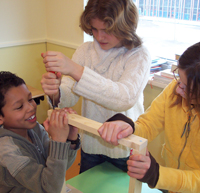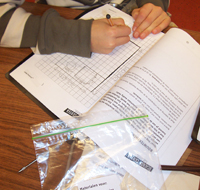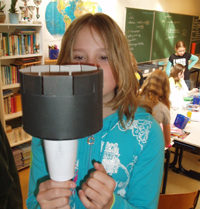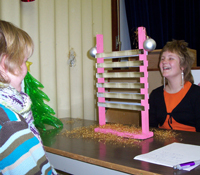Bring the fascination of the science centre into the classroom Inspire article
Amito Haarhuis from the Science Center NEMO in Amsterdam, the Netherlands, describes a project that challenges pupils aged 11-12 to design and create their own exhibits.

by building the exhibit ‘The Magic
Soap Curtain’
Image courtesy of NEMO
During the Science Center at School project, pupils build their own exhibits, similar to those in a science centre – with the help of an employee at a real science centre. Using their exhibits, the pupils set up a science centre in their own school. They present the results of their research into the science behind their exhibits and invite fellow pupils and parents to try them out.
The project in a nutshell
Science Center at School consists of eight mornings or afternoons, spread over at least five weeks. Only the first half-day takes place at a science centre. Here, a science centre employee introduces the project, telling the children what an exhibit is and what they have to think about when they build their own exhibit.

helps students to work in a
more organised way
Image courtesy of NEMO
The rest of the project takes place at school. The pupils work in pairs and choose (from a list provided by the science centre) which of more than 20 exhibits they want to build. They then make a technical drawing of their chosen exhibit, thinking about how they are going to make it and how big it should be. The children would like nothing better than to get down to building the exhibit right away; making a technical drawing slows down this process. It does, however, help the children to work in a more organised way and think before they act.
From their technical drawing and a description provided by the science centre, they then build the exhibit. All descriptions and building instructions can be downloaded from the Science Center at School websitew1. Building the exhibits involves sawing, drilling, cutting and pasting. For this part of the project, extra hands are needed in the classroom: two extra people (parents, trainee teachers or colleagues, for example) should be sufficient.
After they have finished building, the pupils do some research using their exhibit. They study how it works and what scientific phenomenon it demonstrates. Using posters and oral presentations, the pupils then present their research to their classmates, teachers, family and friends, who have the chance to try out the exhibits too.
The main objectives of this project are to encourage an enquiring attitude to science and technology, and to demonstrate to the pupils how they can work together, give presentations (written and oral) and acquire a high level of technical skills.
Successful pilot
The pilot project was carried out in ten primary schools, and pupils rated the project with an average score of 8.5 (on a scale of 0-10.0). The most highly valued part was the building of the exhibits (9.4). The reasons given by the children for the high score were: “because you don’t often get to do things such as sawing; I like that kind of thing” and “once it’s finished – you can see if it works”. Showing the exhibits to other children and parents was also rated highly (8.7): “because you’re happy with what you’ve made and you can show it to other people” and “because some people just couldn’t believe it and were thinking ‘how do they do that?’”.
Girls became more technical

consider yourself technical?
Click on image to enlarge
Image courtesy of NEMO
What was striking was the fact that most of the girls considered themselves ‘not really technical’ before the project, whereas most of the boys considered themselves ‘pretty technical’. After the project, the children considered themselves on average more technical than before: 7% more children regarded themselves as ‘pretty technical’ or ‘very technical’.
More significant is the increase among the girls: after the project, the number of girls who regarded themselves as ‘pretty technical’ rose by 66% and the number who considered themselves as ‘not really technical’ fell by 35%. It seems that the boys generally overestimated their own abilities before the project. By doing the project they got a more realistic self-image. Girls had a more realistic self-image to start with, but generally had less experience with technical activities. By taking part in the project they discovered that they were actually quite good at it, and that it was fun!
Educational trajectory
The project is connected with an educational trajectory for enquiry-based learning and learning by design that NEMO has developed in co-operation with the AMSTEL Institute of the University of Amsterdam.
We distinguished a ‘science trajectory’, to which enquiry-based learning is central (didactics of natural sciences), and a ‘technology trajectory’, to which learning by design is central (didactics of technology). An important aspect of both didactics is that it is the process and not the end product that is most important.
Therefore, guidance by the teacher focuses primarily on acquiring an investigative attitude and technical skills. The Science Center NEMO provides a training session for teachers to prepare for the project.
Enquiry-based learning
It is important to realise that enquiry-based learning begins only once the exhibit has been built: the finished exhibit makes a physical phenomenon or technical principle tangible, so the exhibits lend themselves well to follow-up research.
The children go through three research phases: first, ‘fooling around’ with the exhibit (unfocused investigation), which gives rise to lots of questions; second, ‘focused experimentation’, where specific research questions are included in the lesson descriptions and children can discover answers themselves; and third, ‘theoretical research’, where pupils research using books and the Internet to learn about the science behind how the exhibit works and how those scientific principles apply in daily life.
Learning by design
The lesson description explains how to design the exhibit, as well as the materials and tools required. However, no quantities for materials are given. Before the pupils can establish how much of each material they need, they must decide how big their exhibit will be. Once they have decided this, they sketch a 1:2 scale technical drawing, indicating how the components should be attached to each other.
The children present their technical drawings to each other and their teacher, asking for feedback. They use this feedback to improve their technical drawing.
Most of the time, the exhibits do not work straight away. It is important that the teacher regards the technical problems that the children encounter as novel learning opportunities. Often the teacher will be tempted to think up solutions to help the children. But according to the didactics of learning by design, it is important that children come up with inventive solutions themselves. They can test whether these work immediately and tell the teacher the result.
Examples of exhibits


This exhibit shows a zoetrope, a kind of forerunner of the modern film, developed at the end of the 19th century. From this exhibit, pupils learn something about the phenomenon of light (physics), the working of the eye and brain (biology), and technology (it is a technical product).
This exhibit is a special mirror consisting of loose strips with slots in between them. By placing someone in front of the mirror and someone behind – and having them look at each other in the mirror – together they can make a new face which is a mixture. This exhibit is about light and reflection (physics), and is also a technical product.
Instructions for these and many other exhibits can be downloaded from the Science Center at School websitew1.
Science Center at Schoolis a project of the National Science and Technology Center, the umbrella organisation of Science Center NEMO, the largest science centre in the Netherlands. The National Science and Technology Center is working with the AMSTEL Institute of the University of Amsterdam, the Netherlands National Institute for Curriculum Development (SLO) and ten primary schools.
The project was financed by the European Union under PENCIL (Permanent EuropeaN resource Center for Informal Learning) project. Under this banner, 14 European science centres and museums worked with schools and universities to try to find new ways of shaping science education.
Help is at hand
If you are interested in this project and would like more information, Science Center NEMO would be happy to help. Contact Amito Haarhuis (haarhuis@e-NEMO.nl).
Web References
- w1 – More information about the project is available on the Science Center at School website. To see all the English-language lesson materials for this project, click on ‘Primary Education – Teachers’ and then ‘Lesson materials’: www.sciencecenteropschool.nl/index.php?id=95





